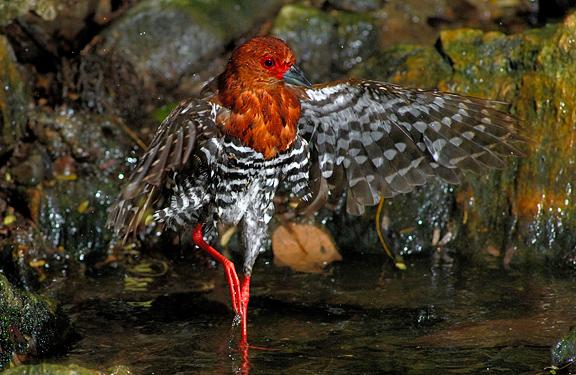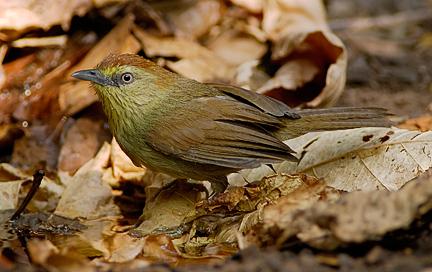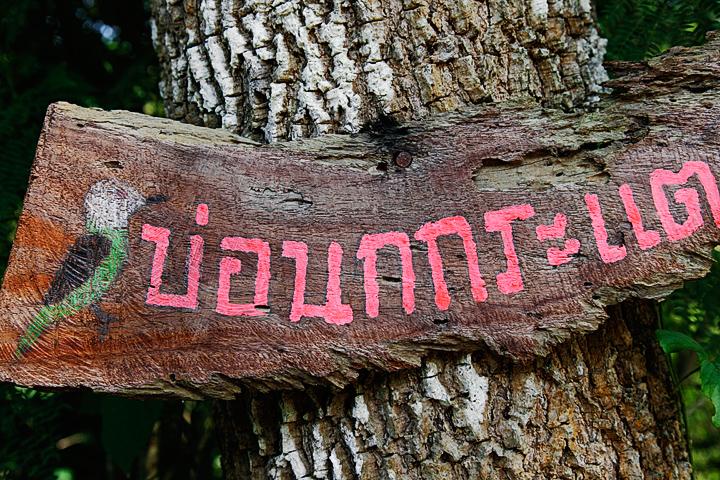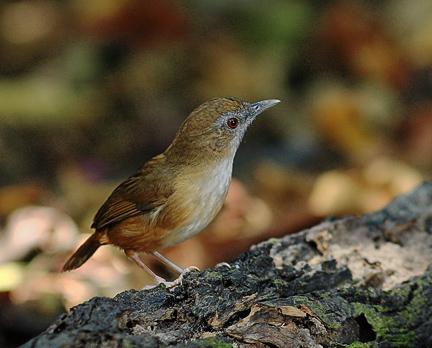Bird Hides and Water Holes: A Model Conservation Project near Kaeng Krachan National Park -Thailand
Kittipon Bouranasompop and Robert DeCandido PhD
In July 2008, two of us, Kittipon Bouranasompop ("Gunn") and Captain Kittayarn Sumpantaluk heard of a number of water holes near Kaeng Krachan National Park in western Thailand. We suspected that poachers had devised these to capture wildlife. Upon investigation we learned that the poachers were shooting birds to eat including Scaly-breasted Partridge (Arborophila chloropus) and Chinese Francolin (Francolinus pintadeanus), while trapping others such as White-crested Laughingthrush (Garrulax leucolophus) and White-rumped Shama (Copsychus malabaricus) to sell in local markets for their ability as songsters. Lesser Mouse Deer (Tragulus kanchil) and Barking Deer (Muntiacus muntjak) were also taken.
The poachers were locals who knew that in the dry season, by simply digging a series of small water holes (measuring approx. 40 cm long by 25 cm wide by 6 cm deep) in the forest and placing fruit (papaya and bananas) nearby, all sorts of wildlife would stop by for a visit. Access to the water holes was easy - all were

Scaly-breasted Partridge
All bird photos Kittipon Bouranasompop 2008-2009
constructed on stream beds in the dry season. These dry water courses lacked vegetation and were a natural pathway through the scrub forest. The poachers returned each day to add water to the holes, and place more fruit as needed. As a result, birds and mammals, and even snakes such as King Cobras (Ophiophagus hannah) came to drink on hot days, while several species of squirrel and tree shrew ate the fruit nearby. Any of these could be easily harvested by a patient hunter willing to sit in a nearby blind for an afternoon.
Since the water holes were located on military land, we had some hope that we if could secure the cooperation of the local army higher-ups to officially allow the water holes to exist, we might entice the poachers to participate in a conservation oriented project to protect instead of harvesting wildlife. We also hoped to convince the poachers that they might actually do better for themselves financially by enticing Thai photographers and birders from all parts of the world to come observe the wildlife at the water holes during the dry season.

Slaty-legged Crake
At first the poachers were skeptical. They were puzzled why anyone would want to pay money to sit in the forest just to look at birds. The poachers had used this method of attracting wildlife to water holes in this particular area for five years at least - and regionally it is a traditional way of hunting. We now work with five (former) poachers, and have interest from at least twenty more. All are men, and average about 30 years in age. Each man heads a relatively poor family that farms on a small scale. These families have lived in the area for the last twenty years, moving here after the logging companies finished their work in Kaeng Krachan National Park and environs.
Persuading the poachers to take up the cause of conservation proved not too difficult, once the first birders to visit had a bit of luck. After the first water hole was set up for observation, a photographer captured the rare Slaty-legged Crake (Rallina eurizonoides) using only a 300mm lens. Once other bird photographers saw the image, we quickly had to create a waiting list for those who also wanted an image of this seldom seen bird in Thailand. Indeed one water hole became so popular with photographers that the former poacher who now protects wildlife there had to quickly sign a contract for a cell (mobile) phone. He had more than 250 visits by birders and photographers to schedule at his water hole just from February to October 2009.

Lesser Mouse Deer
- so arriving after 2 pm is fine. Most activity occurs between 3:30 pm to 6:30 pm each day. We wear shorts and a t-shirt, and use a small amount of insect repellant to keep the bugs away.

Red-legged Crake

For more information about availability, and booking
a bird hide for yourself, contact KB at his email address below, or visit the Baan Maka web site (www.BaanMaka.com)

From a scientific perspective, results have been remarkable to date. Species that were once thought to be rare in this area, such as the Red-legged Crake (Rallina fasciata), we have found to be common at certain water holes. We have seen as many as 6-8 individuals of different ages and both sexes coming to bathe and drink at one location. Also observed have been juvenile Slaty-legged Crake, suggesting that this species may be breeding in this area. We have photographed Scaly-breasted Partridge, Large-scimitar Babbler (Pomatorbinus hypoleucos), Abbottโs Babbler (Malacocinda abbotti), Striped Tit Babbler (Macronous gularis), Eared Pitta (Pitta phayrei), Orange-headed Thrush (Zoothera citrine gibsonhilli) and Lesser Mouse Deer.
For the future, we would very much like to have more international birders visit the water holes to see the birds. The best months to visit are from mid-November through April. The charge is 200 baht/person per day (about $6 USD), and all of the money is paid directly to the former poachers. If this project continues to be a success, we would like to expand it to different habitats in the area. We also would like to set up water holes within nearby Kaeng Krachan National Park. Park officials there currently believe that by providing water holes and food to wildlife, we are "taming" them, and the birds and mammals are no longer wild. Yet we have seen how well bird blinds and man-made water holes work in other parks in Thailand such as the one in Phu Kheo national forest. There we have photographed trogons, pittas and broadbills coming to drink and bathe - and then have watched them disappear back into the forest. Time will tell if our plan will continue to go forward. In the meantime, do come to watch and photograph wildlife at the water holes just outside of Kaeng Krachan National Park. Your support makes for a win-win-win situation for birds, people and conservation.

Large Scimitar Babbler

Abbott's Babbler
Authors:
Kittipon Bouranasompop
Baan Maka Lodge
84 Moo 8
Song Pinong District
Kaeng Krachan City
Phetchaburi Province, Thailand
Email: Nokgag@gmail.com and www.BaanMaka.com
Robert DeCandido Ph.D.
1831 Fowler Avenue
The Bronx, New York 10462
Email: rdcny@earthlink.net
Acknowledgements
Our special thanks to our significant others: Narida Adithapworaphan and Deborah Allen whose ongoing help, support and company allow us to do what we do. We thank the Thai military, particularly the Special Forces Group of Song Pinong District, who graciously provided permission and provided assistance to make this conservation project possible. We also thank water hole owner Lung Sin Iamsumang, and photographers Bunrot Keowyu, Parinya Padungthin and Suppalak Klabdee.

Former Poacher Lung Sin Iamsumang at entrance to the trail that leads to his bird blind and water hole.

Typical water hole built on dry stream bed

Two bird hides in the forest. The one on left for those with 300-400mm lenses; the one on right (back) for longer lenses.